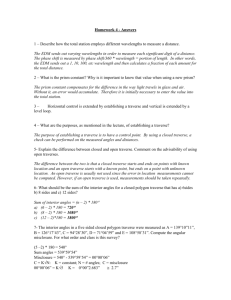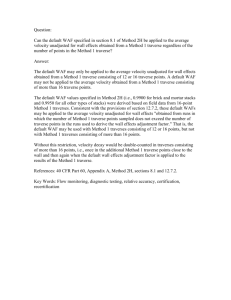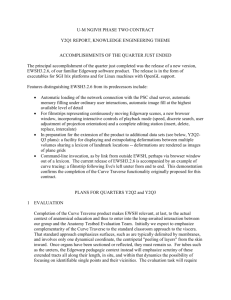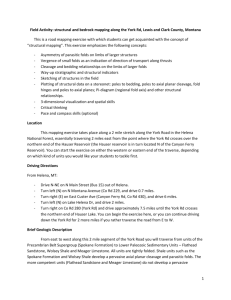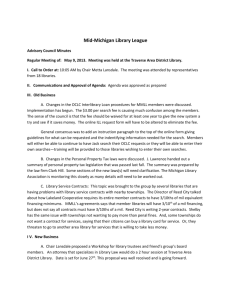Closed Traverse - Land Surveyors United
advertisement
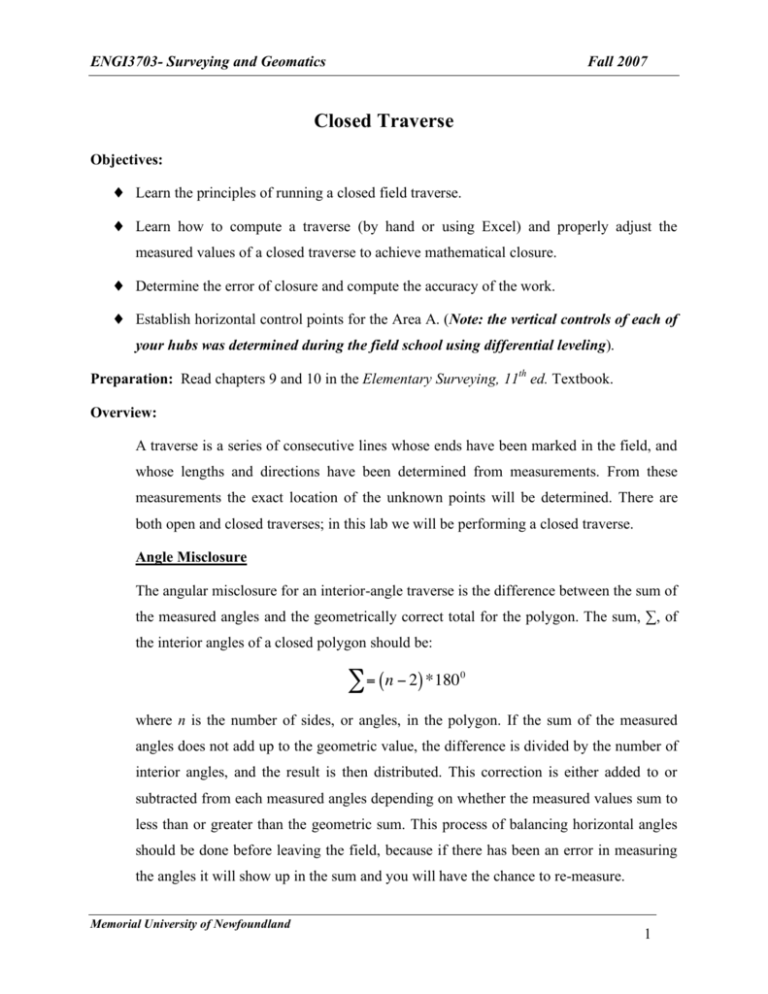
ENGI3703- Surveying and Geomatics Fall 2007 Closed Traverse Objectives: ♦ Learn the principles of running a closed field traverse. ♦ Learn how to compute a traverse (by hand or using Excel) and properly adjust the measured values of a closed traverse to achieve mathematical closure. ♦ Determine the error of closure and compute the accuracy of the work. ♦ Establish horizontal control points for the Area A. (Note: the vertical controls of each of your hubs was determined during the field school using differential leveling). Preparation: Read chapters 9 and 10 in the Elementary Surveying, 11th ed. Textbook. Overview: A traverse is a series of consecutive lines whose ends have been marked in the field, and whose lengths and directions have been determined from measurements. From these measurements the exact location of the unknown points will be determined. There are both open and closed traverses; in this lab we will be performing a closed traverse. Angle Misclosure The angular misclosure for an interior-angle traverse is the difference between the sum of the measured angles and the geometrically correct total for the polygon. The sum, ∑, of the interior angles of a closed polygon should be: # = (n " 2) *180 0 where n is the number of sides, or angles, in the polygon. If the sum of the measured angles does not add up to the geometric value, the difference is divided by the number of ! interior angles, and the result is then distributed. This correction is either added to or subtracted from each measured angles depending on whether the measured values sum to less than or greater than the geometric sum. This process of balancing horizontal angles should be done before leaving the field, because if there has been an error in measuring the angles it will show up in the sum and you will have the chance to re-measure. Memorial University of Newfoundland 1 ENGI3703- Surveying and Geomatics Fall 2007 Departures and Latitudes After balancing the angles, the next step in traverse computation is calculation of either azimuths or bearings. This requires the direction of at least one line within the traverse to be either known or assumed. Once all the azimuths are calculated, traverse closure is checked by computing the departure, or easting (ΔX) and latitude, or northing (ΔY) of each line. The rectangular coordinates of the new point can then be determined with respect to the known point. If the known point already has coordinates, the ΔX and ΔY are added algebraically to these coordinates. This procedure is followed around the traverse and the coordinates for each new point are determined. In equation form, the ΔX and ΔY of a line are: "X = L sin # "Y = L cos # where L is the horizontal length and α is the azimuth of the line. Traverse Linear Misclosure ! and Relative Precision For a closed traverse, it can be reasoned that if all angles and distances were measured perfectly, the algebraic sum of the departures of all lines in the traverse should equal zero. Likewise, the algebraic sum of all latitudes should equal zero. Unfortunately even with the best equipment and practices, this is impossible and so you will need to calculate the error of closure in the X (east or departure) and Y (north or latitude) directions. The error of closure is computed as: Cx = "#X Cy = "#Y Where: Cx = total closure distance of X and Cy = total closure distance of Y. The error of linear closure (E)!is determined using Pythagorean’s Theorem as: E = Cx2 + Cy2 ! Memorial University of Newfoundland 2 ENGI3703- Surveying and Geomatics Fall 2007 The relative precision, or precision ratio of a traverse is expressed by a fraction that has the linear misclosure (E) as its numerator and the traverse perimeter (P) or total length as its denominator. Re lative Pr ecision = E P This number will be small and should be converted to a fraction of 1/ (Relative Precision). You should ! round relative precision to the nearest 10 or probably 100. In other words, precision reads something like “one in sixteen hundred” which interpreted means that for every 1600 units (i.e. feet, inches, meters, miles) of your traverse, you will have 1 unit of error. As a further example, if the vector of closure is 0.081 feet and the perimeter distance is 2466 feet, the degree of accuracy would be 1/30,000. You want to round down because to round up would be to report more accuracy than you actually attained. Traverse Adjustment (Compass Rule) For any closed traverse the linear misclosure must be adjusted (or distributed) throughout the traverse to “close” or “balance” the figure. There are several elementary methods available for traverse adjustment, but the one most commonly used is the compass rule (Bowditch method). The Compass Rule Adjustment is used in survey computations to distribute the error of closure proportionately between the different legs of the traverse. If done correctly the traverse will close precisely to the point of origin. The correction to each traverse leg is determined by the ratio of the distance between the two points and the total perimeter as given in the following equations: ABy _ Corr = Cx ABy _ Corr = Cy AB P AB P where: ABx_Corr is amount of adjustment for length AB in the X direction, ABy_Corr is amount of adjustment for ! length AB in the Y direction, AB is length between points A and B and P is total distance around the perimeter of the traverse. Memorial University of Newfoundland 3 ENGI3703- Surveying and Geomatics Fall 2007 Instruments to be used: Check out the following equipments: ♦ Total Station/digital theodolite ♦ Tripod ♦ Prism/tape ♦ Pegs Procedure: 1. Using a Total station/theodolite, run a closed traverse such that it includes the two hubs (wooden stakes) of your designated area (previously established) and the two horizontal control points. The instructor or TA will show you these two horizontal control points. Calculate the azimuth of the line that connects the control points from the known X, Y location of these points. 2. Start your traverse on one corner of the area you staked out. 3. Measure the horizontal angle and distance between the two adjacent points. Each person will set up and run the instrument for at least one point of the traverse. 4. Each horizontal angle should be measured using the telescope in direct and reverse position. Record the average of the angles. 5. Compute the misclosure for the geometry and check that the internal angles of your parcel sum to (n-2) *180 (should be within ± 30’ of 360°). If the sum of the interior angles is off by more than 30’, go back and re-survey. 6. Balance the angles as outlined in the overview section of this manual. 7. Using the starting azimuth (from the control points) and your adjusted angles, compute the azimuths of all of your traverse legs. 8. Using your measured horizontal distances and the azimuths, compute the latitudes and departures of all sides of your parcel. 9. Sum up the latitudes and departures and determine the misclosure in the X and Y direction. Compute the linear misclosure and the relative precision in proportion to the total distance of the traverse (e.g. 1/10,000) Memorial University of Newfoundland 4 ENGI3703- Surveying and Geomatics Fall 2007 10. Adjust the misclosure using the Compass Rule (Bowditch) method. Check that the adjusted latitudes and departures add to zero. 11. Compute the coordinates of your parcel corners using the starting coordinates of one of the control points. Example: X = X coordinate of the previous point + ΔX Y = Y coordinate of the previous point + ΔY Area C Area B Area A Figure 1. Area to be mapped for the term project Memorial University of Newfoundland 5
